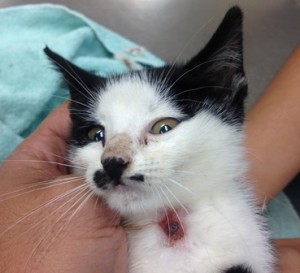In late summer and early fall, we sometimes see an infection called Cuterebrosis in cats. It starts with a botfly, which is a genus of Cuterebra.
Botflies lay eggs on blades of grass or in nests. Once the eggs hatch, they release tiny worms or maggots that crawl onto the skin of animals passing by. Often they attach to rodents and rabbits that live in the wild. However, a passing cat or kitten can become infected, too.

Kitten with Cuterebrosis infection
One of our cases was a kitten, as seen in the accompanying photo. In this case, the Cuterebra worm most likely crawled around on the kitten until it found an orifice to enter, which happened to be a small wound on the kitten’s neck area.
Once an orifice is found, a lump is formed on the skin where the worm lives called a warble. The worm comes up for air every few seconds which we can clearly see. When removing it, we must be careful to not crush it. We want to remove the worm intact so it does not release a toxin.
Video – Cuterebra worm in kitten
The danger is that once larvae migrate through the cat’s tissues, further illness follows with symptoms that include respiratory signs, neurological signs or ophthalmic (eye) lesions.
When a Cuterebra worm is found and when a positive Cuterebra diagnosis is made, a broad-spectrum anti-parasite medication is typically administered. A corticosteroid treatment will be given before administering the medication. The anti-parasite medication can be administered either to alleviate the signs caused by any worms suspected of migrating into the lungs or to kill larvae in other tissues, including the central nervous system.
It is therefore important to protect pets from being outside and make sure they don’t have any scratches or wounds that can become a home for Cuterebra. It is equally important to have your veterinarian examine pets that come from outdoors for possible wounds/Cuterebra that are covered by fur or often missed.
That being said, rabies is endemic in our area, and the virus can live up to three hours in wounds. Never clip and clean or physically examine wounds yourself and without gloves, especially on strays. This applies to even your own rabies vaccinated pets. The rabies vaccine protects your pet but not you, the owner, if exposed to any blood, saliva, or other secretion. If exposed, please report it to your family doctor and veterinarian immediately.
Remember that a mother cat permitted to roam outside can carry a worm indoors that attaches to one of her indoor kittens. Also, the worms can infect the same cat time and again.
Please call our office if you notice any symptoms, have further questions, or wish to make an appointment for your pet’s wellness exam. We are here to help.
Dr. Joe Martins, DVM, Belle Mead Animal Hospital



